How to Boost Room Acoustics with Smart Interior Designing?
Working on the footing to boost room acoustics through smart interior work is one of the most efficient ways in which you can improve the wound quality of your room
Every single object in the room affects how sounds travel and how they sound to us.
If you have read the properties of sound and how it travels, then you must know that bare walls and floors create echoes.
They bounce the sound around the environment and make it unclear and harsh.
However, by different elements, you can mitigate the effect of which sound is disturbed.
These elements absorb the sounds and reduce the echoes, making the room inviting and warmer.
If you are also worried about the acoustics problem, then worry no more. We have got you covered.
In this article, we will delve into the detailed aspects and explore the elements through which we can fix this issue.
Elements that Can Help Boost Your Room Acoustics
As detailed above, several elements can help you work on your room’s acoustics, furniture being one of them. Other elements can be of immense help.
These elements not only uphold the style of your room but are also functional.
Here are a few to help boost your room’s acoustics through smart interior design.
Additionally, exploring different types of ceiling designs can significantly enhance your room’s acoustics; read more about this in our detailed guide on ceiling styles and their acoustic benefits.
1. Placement of a Rug

Having a rug of comfortable material feels extremely cozy on the feet and is easy on our ears.
Rugs have the potential to reflect the sound between floor and ceiling.
For the positioning part, imagine where the guests in your room will be lounging most often.
The idea of working with ‘thick padding’ is ideal. Doing so also brings the advantage of lying down to enjoy a perfect leisure time that offers comfort with its material.
2. Usage of an Ottoman

Having a good-quality ottoman at the center of your living room helps enhance the room’s overall look and acoustics.
Swapping the traditional glass table with this padded ottoman is a win-win situation.
This also serves well both for the cups and your feet.
3. Creating a Sound Library

Who doesn’t enjoy having a wall in their home filled with fascinating books?
Bookshelves have a massive power in improving room acoustics. Furthermore, symmetrical design is not a concern.
You can let in more sound by arranging records, books, and special items in irregularly sized shelf openings.
The entire arrangments look great, as depicted in the image above
4. Designing Your Room with a Curtain Wall

Working to improve your room’s acoustics can never go down without having curtains.
These are the wise design choices that enhance both sound quality and beauty.
To retain more sound in the space where the jam session is taking place, or any other recordings even the hanging drapes from the floor to the ceiling should a go-to option for you.
5. Go all Green

Plants are a great addition to working for a full sound.
Beyond brightening the mood of almost any room, they have a positive and symbiotic relationship with music.
It is rightly said the bushier the plants are, the better the result can get.
You can also think of adding different elements altogether to yield better results.
6. Adding Drywalls for Best Sound Insulation

Drywalls take up to two weeks to set up. Drywalls or Plasterboard can be used to create a wide range of multipurpose areas.
A wide range of performance factors, acoustics being the primary, impact, moisture, and loading parameters, are available for plasterboard partitions.
They provide a hassle-free construction process and need 95% less water because they are simple to erect and remove if needed.
7. Designer Ceilings

Even after exploring these many options, this could be the one for you if you are looking for something special.
To work for the acoustics, we often forget about the ceilings.
Easy-to-construct designer ceilings are the best way to transform and work for the room’s acoustics.
These are easy to inculcate and come in various shapes, sizes, and colors.
An extensive range of designer ceilings with excellent sound absorption qualities are also available.
Ceilings of this kind are also great options to enhance the overall ambiance of any space.
8. Adding Adequate Amount of Furniture

Sound waves must be split up; usage of non-soft objects is the most effective technique.
Anything in the room with a hard surface, such as your coffee table or plant-filled pedestals, helps with the acoustics since it breaks up sound waves.
Consequently, it’s critical to “pack” the area with enough furniture to provide places where sound waves can be broken up.
To put it another way, the space shouldn’t be very vacant.
9. Working for the Stairway
A stairwell frequently has multiple parallel walls that form a cube shape, allowing sound waves to reverberate and produce an echo freely.
All you have to do to tackle this is hang things on the wall surfaces that absorb sound waves.
Today’s homes rarely have the traditional staircase wall hangings.
But you may still choose to hang a textile along one wall of the staircase or put anything on the walls that restricts sound waves, like little shelves or sound-absorbing panels.
Conclusion
Improving the interior’s acoustics involves using various elements to absorb sound and reduce the echoes.
This helps create a clean and warmer environment that enhances the room’s overall setup.
Key strategies include using rugs, working on ceilings, adding sufficient furniture materials, and others listed in our article above.
It is crucial to understand that careful implementation of these elements will only work for the benefit of working on the acoustics.
The option available on the working stairway is personal and is limited to those who value it.
We hope that this guide will be of great help in working on your room’s overall acoustics. Any views and recommendations are gratefully invited.
Happy Designing!








